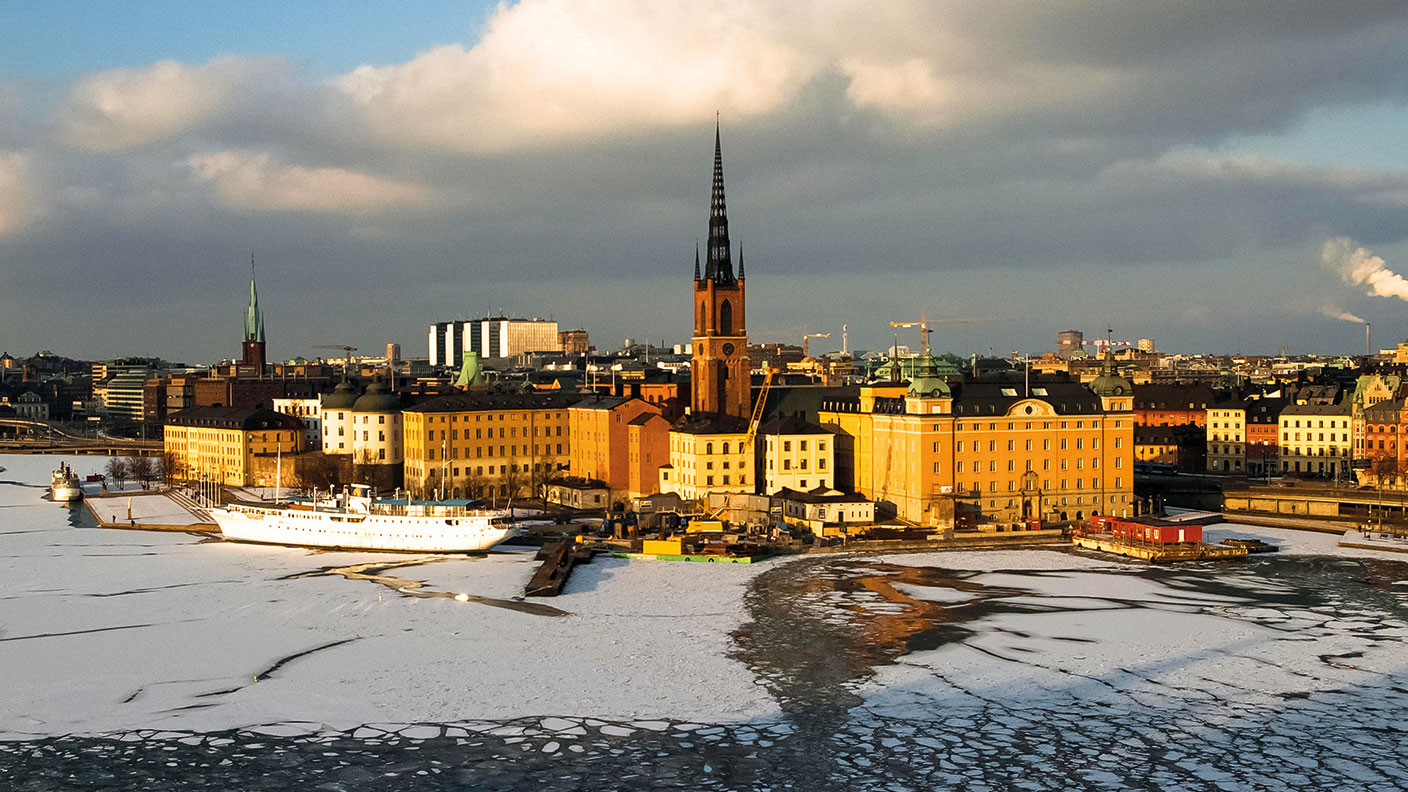Navigating the weird world of negative interest rates
Investors are paying good money to be allowed to lend money to governments across the world. What on earth is going on, and what does it mean for your money? John Stepek reports.

What if your bank was to offer you a ten-year fixed-rate mortgage on which you had to pay absolutely no interest? Better still, at the end of the ten-year term, you'd find that you had repaid less than you actually borrowed in the first place. Sounds like a dream, doesn't it? But if you live in Denmark, it's a reality. Jyske Bank, the third-largest bank in Denmark, is now offering a ten-year deal at a rate of -0.5% a year.
Meanwhile, Nordea Bank is offering 20-year deals at 0% (ie, interest free), while borrowers can already get 30-year deals at 0.5%. Of course, the flipside is that savers get 0% interest, or in some cases are charged for leaving their money in the bank (Swiss bank UBS is planning to introduce a 0.6% annual charge on deposits above €500,000). Welcome to the wacky world of negative interest rates.
Across the globe, around $15trn-worth of government debt now trades on negative yields in other words, debtors get paid to borrow, rather than the other way around. Negative rates have been most obvious in Japan and the eurozone. Unlike in the UK and the US, central banks in these countries have set negative base rates. The European Central Bank rate is -0.4%, while in Japan the rate is -0.1%. In Denmark, Switzerland and Sweden, rates are even lower.
MoneyWeek
Subscribe to MoneyWeek today and get your first six magazine issues absolutely FREE

Sign up to Money Morning
Don't miss the latest investment and personal finances news, market analysis, plus money-saving tips with our free twice-daily newsletter
Don't miss the latest investment and personal finances news, market analysis, plus money-saving tips with our free twice-daily newsletter
Yet even in the US and the UK, bond yields are close to, or at, fresh record lows and Joachim Fels of US bond giant PIMCO recently argued that investors should be prepared to see negative rates in the US too, should the Fed be forced to restart quantitative easing. Are bonds in a bubble? So what's going on here? The most straightforward answer is that this is nothing more than a bubble. An unusual bubble, to be sure it's strange that an asset as dull and as sensible as a government bond should be the subject of market mania but a bubble nonetheless.As John Authers reports on Bloomberg, Chris Watling of Longview Economics has analysed bond prices using the four criteria for defining a bubble outlined by economist Charles Kindleberger in his 1978 classic Manias, Panics and Crashes.
Firstly, you need a ready supply of cheap money we have that. Secondly, debt is taken on during the process of the bubble inflating you can certainly argue that central bank money printing counts as "debt" for these purposes. Thirdly, you need extreme valuations. As if negative yields weren't extreme enough, Watling points out that the yield on both long-term Swiss and Swedish bonds has never been lower going all the way back to 1870, while it's a similar story for long-term UK government debt going back to 1700.
It's also clear that prices have gone up in the "parabolic" manner you'd associate with bubble valuations. They might be viewed as a sober-minded, boring bunch compared with equity investors, but bond investors have made a lot of money by betting on ever-lower yields. When Austria issued 100-year debt with a yield of just over 2% back in summer 2017, people wondered who would buy it. As it turns out, in 2019 so far, that bond has made a capital gain of more than 60% as the yield has toppled (bond prices move inversely to yields).
Meanwhile, German 30-year bunds have made nearly 30%, and UK 50-year gilts are on around 20%, notes Tommy Stubbington in the Financial Times. While many bonds are bought by pension funds (who need to match long-term liabilities with long-term assets), the Austrian bond "was an exception, with asset managers accounting for nearly two-thirds of orders, suggesting that many buyers were using the bond to take an outsize bet on lower rates". In other words, prices have been driven higher at least in part by pure speculation.
Finally, as was the case in the tech bubble, people are dreaming up all sorts of "new normal" explanations to justify negative yields. Some ask why savers should be compensated for taking no risks, and argue that it makes sense for bond holders to effectively be charged to park their money with governments. This makes sense on the surface, but when you look at what's going on in the market, it's not in fact what's happening. If you really believe that lending to the Austrian government for 100 years is virtually risk-free, then you're a more trusting person than me. Instead, it looks much more like a massive, tech-stock-style momentum trade. So the bubble explanation seems a good one.
What could burst it? Either the withdrawal of cheap money (which doesn't seem likely right now), or perhaps a reversal in sentiment on the global outlook. With Germany in recession and the US yield curve inverting, the odds on that may not seem great. That said, with US president Donald Trump now delaying tariffs on Chinese goods until mid-December, any kindling of hope for a trade deal could stop the bond rally in its tracks, just as it did in late 2016, when yields also went massively negative.
At that point, it could look nasty for bond investors.As Stubbington notes: "Although bond yields have been at historically low levels for years, fund managers have more than made up for lack of yield with hefty price gains on their portfolios as bonds rallied. Once the price gains fizzle out, they will be left contemplating an exceptionally bleak bond investing landscape". Or are they pointing to something far worse? Of course, there is another explanation, which is that the unprecedented conditions in bond markets could be warning us of something that's never happened before.
Russell Napier, financial historian and analyst, notes in his "The Solid Ground" newsletter this month that the collapse in bond yields could be signalling something much more dramatic the disintegration of the eurozone, "or at least its end as a currency". The problem is that negative interest rates are bad news for bank profitability, as can be seen by the slump in bank share prices, in the eurozone in particular.
Napier argues that "ever-lower levels of eurozone interest rates will stop the growth in commercial bank balance sheets and lead to a tightening in monetary policy", which would worsen any recession in the region. He also argues that rules introduced in the wake of the eurozone crisis, which mean that large depositors in eurozone banks can be "bailed in" should a bank prove to be insolvent, may already be having the unintended consequence of driving capital flight from the banks and into government bonds instead.
"This movement of funds drives a deflationary spiral" by undermining banks' balance sheets and ability to lend. That in turn increases the odds of a disastrous recession that could ultimately result in the introduction of capital controls in an effort to save the euro (which would, of course, only increase political anger in the region, thus undermining the project and the currency altogether). On the other hand, a devaluation of theChinese yuan driven by trade pressures and a weakening economy could be at least as disruptive.
Albert Edwards of Societe Generale argues that the yuan's recent weakness may not be over."I believe the risk that Chinese policymakers lose control is very high indeed, not just in relation to the risk of capital flight... but also the clear and present vulnerability of the banking sector."
A market of extremes These scenarios may seem extreme to some readers, but regardless of whether you favour the "bonds are in a bubble" camp or the "bonds are issuing a dire warning" argument, there is no doubt that, as James Ferguson of the Macrostrategy Partnership points out, many markets not just bonds are currently at extreme levels, and therefore look vulnerable to surprises in either direction, whether inflationary or deflationary.
The ratio of US equity prices to GDP (once viewed as Warren Buffett's favourite valuation measure) is at a 60-year high, driven by "growth" stocks (which also benefit from low interest rates); gold is at a near-30-year high compared with silver (which typically only happens during a recession); and oil production is low (which could spell higher oil prices and shock those expecting ongoing "quiescent inflation"). How can you defend your portfolio? We look at potential investments to consider in the box opposite.
What to hold in a negative-yield world
No doubt you're thinking: where can I get a negative interest-rate mortgage? Unfortunately for homeowners, the UK is not quite at that stage (yet). However, it's probably worth turning to page 26 to check whether you are getting the best rate on your cash savings you won't get a "real" return with UK inflation currently sitting at 2.1%, but you can certainly improve on the sub-1% seen on many accounts.
As for what to invest in if we end up in the deflationary collapse scenario, then the obvious answers include more government bonds. The trouble is, as James Ferguson points out, a lot of this is in the price. "The extreme consensus today seems particularly vulnerable to a change in inflation expectations, which, with wage growth and gold prices both growing, look particularly exposed to oil prices."One obvious option to have in your portfolio is gold.
We've always said that investors should have a 5%-10% allocation to physical gold as a core part of their portfolio, and our negative-rate world demonstrates why this is. One objection to owning gold is that it pays no yield, and in fact costs money to store. Yet if government bonds cost money to invest in too, then this is no longer an issue. As a result, the gold price has enjoyed a strong rally this year and could have further to go.
Equally, while it's a bit "have your cake and eat it", any inflationary surprises should eventually be good for gold too – lower "real" interest rates tend to benefit the yellow metal. An easy way to get exposure is via the exchange-traded fund ETFS Physical Gold (LSE: PHAU; PHGP for sterling-denominated version).
More adventurous readers might want to consider digital currency bitcoin. If negative interest rates spread to cash deposits, the idea of owning a digital currency that can't be devalued by a central authority might not seem quite as outlandish as it does now. You can read more about how to buy bitcoin here.As for stockmarkets the US looks too expensive, and the eurozone is vulnerable to issues with its banking sector. A better bet might be to invest closer to home, what with sterling close to record lows. Max King suggests some commercial property plays that could benefit.
Get the latest financial news, insights and expert analysis from our award-winning MoneyWeek team, to help you understand what really matters when it comes to your finances.
John Stepek is a senior reporter at Bloomberg News and a former editor of MoneyWeek magazine. He graduated from Strathclyde University with a degree in psychology in 1996 and has always been fascinated by the gap between the way the market works in theory and the way it works in practice, and by how our deep-rooted instincts work against our best interests as investors.
He started out in journalism by writing articles about the specific business challenges facing family firms. In 2003, he took a job on the finance desk of Teletext, where he spent two years covering the markets and breaking financial news.
His work has been published in Families in Business, Shares magazine, Spear's Magazine, The Sunday Times, and The Spectator among others. He has also appeared as an expert commentator on BBC Radio 4's Today programme, BBC Radio Scotland, Newsnight, Daily Politics and Bloomberg. His first book, on contrarian investing, The Sceptical Investor, was released in March 2019. You can follow John on Twitter at @john_stepek.
-
 Investors will reap long-term rewards from UK equities
Investors will reap long-term rewards from UK equitiesOpinion Nick Train, portfolio manager, Finsbury Growth & Income Trust, highlights three UK equities where he’d put his money
-
 The graphene revolution is progressing slowly but surely
The graphene revolution is progressing slowly but surelyEnthusiasts thought the discovery that graphene, a form of carbon, could be extracted from graphite would change the world. They might've been early, not wrong.
-
 What would negative interest rates mean for your money?
What would negative interest rates mean for your money?Opinion There has been much talk of the Bank of England introducing negative interest rates. John Stepek explains why they might do that, and what it would mean for your money.
-
 Is the UK heading for negative interest rates?
Is the UK heading for negative interest rates?News The hints that negative interest rates are heading for Britain are now coming thick and fast.
-
Prepare yourself for negative interest rates
Editor's letter There is a lot of talk about negative interest rates coming to the UK. They're a terrible idea, says Merryn Somerset Webb.
-
Trump urges the US Federal Reserve to bring in negative interest rates
News Donald Trump has urged the Federal Reserve to embrace negative interest rates.
-
 What are negative interest rates and could they happen here?
What are negative interest rates and could they happen here?Analysis Negative interest rates – where banks pay you to borrow money – now exist in many parts of the world. John Stepek explains why they are a terrible idea, and how likely we are to see them in the UK.
-
The dangers of negative interest rates
Features Negative interest rates could spark the next financial crisis. And central bankers could end up the object of the public's wrath, says Merryn Somerset Webb.
-
How negative interest rates could spell the death of cash
Features In the topsy turvy world of negative interest rates, the pound in your pocket undergoes a bizarre change. John Stepek explains what that means for investors.
-
Could interest rates go negative?
Features The Bank of England has cut interest rates and expanded quantitative easing to boost the economy. If this fails, what might it try next? Matthew Partridge reports.
